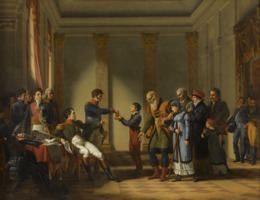Nationality French Name Jean-Charles Tardieu | ||
 | ||
Born 3 September 1765 ( 1765-09-03 ) Paris, France | ||
Jean-Charles Tardieu, also called "Tardieu-Cochin" (3 September 1765 – 3 April 1830) was a successful French painter during the ages of Napoleon and of the Bourbon Restoration. His work was primarily historical, but also included landscapes, portraits and religious subjects.
Contents

Biography
Jean-Charles Tardieu was born on 3 September 1765 in Paris, son of Jacques-Nicolas Tardieu and Elisabeth Claire Tournay. His father and his grandfather, Nicolas-Henri Tardieu, were both members of the Academy and the King's engravers. His father's cousin was the engraver Charles-Nicolas Cochin, who left him a small legacy when he died in 1790. Cochin also treated him as a sort of pupil and gave him advice. He was formally placed under Jean-Baptiste Regnault for his artistic training. He failed to get the Grand Prix de Rome, but the second prize of the Prix de Rome was awarded to him in 1790. His father died on 9 July 1791.
A passionate artist with great skill in composition, Tardieu exhibited in various salons, and achieved considerable success. He took part in a number of exhibitions in the Louvre between 1806 and 1823. In 1808 he was granted a housing allowance. The great majority of his works were bought by the government or commissioned by the government.
Tardieu had excellent connections and seems to have been fully employed during the reigns of Napoleon, Louis XVIII and Charles X of France. Several of his works were bought for the house of the latter sovereign. He made a large number of tableaux for the government, which were placed in the Luxembourg, Versailles, Saint-Cloud, Fontainebleau and Compiègne palaces and also at the Musée des Beaux-Arts de Rouen, Musée des Beaux-Arts et d'archéologie de Besançon, Rouen Cathedral, Nîmes Cathedral and Lons-le-Saulnier Cathedral.
In his later years, Tardieu worked on religious tableaux and landscapes. Tardieu died in Paris on 3 April 1830. His son Jules-Romain Tardieu was born in Rouen on 28 January 1805. Jules was to become a connoisseur of the arts and letters, a writer, publisher and bookseller, and a member of the Academy of Caen.
Œuvres
Tardieu-Cochin's work was primarily historical. He often took classical and poetic subjects. He also made copies of several paintings of saints by Philippe de Champaigne that were commissioned by the king's house. Almost all his works are held in public collections including, among others, those in the Rouen Cathedral, and in the museums of Besançon, Le Havre, Marseille and Versailles. Among the most successful are Halte en Égypte, Jean Bart à la cour, la Conversion du duc de Joyeuse, Frédéric-Guillaume chez le grand Frédéric, Louis XVIII à Mittau et l’Aveugle au marché des Innocents.
Paintings
Some of the more notable of Tardieu's paintings:
Other notable works include:
In addition, public collections hold the following:
